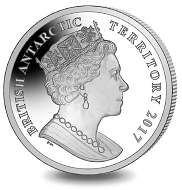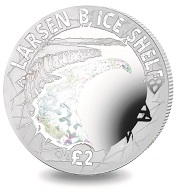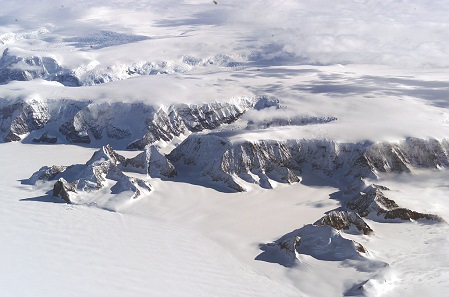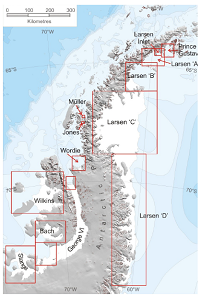June 1, 2017 – To highlight the effect of global warming on the Antarctic the latest coin produced by British Pobjoy Mint features an image of the Larsen B Ice Shelf which has a hologram effect struck onto the coin.
Great Britain / 2 GBP / Sterling Silver / 28.28g / 38.60mm / Mintage: 2,002.
The hologram represents the part of the ice shelf that collapsed 15 years ago which retreats as you tilt the coin. The rim of this coin has been designed with a cracked ice effect that ties together the whole theme of the coin very effectively.
Larsen Ice Shelf in Antarctica.
The Larsen Ice Shelf is a long, fringing ice shelf consisting of three sectors situated in the northwest Weddell Sea and extending along the Antarctic Peninsular. During the period of 31 January to March 2002, the Larsen B Sector of the shelf partially collapsed and 3,250 km2 of ice, 220m thick, disappeared into the sea in about a week. A study conducted by NASA in 2015 concluded that at the remaining part of the Larsen B sector will collapse by 2020. A shocking fact when you consider that the shelf has remained stable for the past 10,000 years!
The ice shelves of the Antarctic peninsula, including the different Larsen sectors. Photo: A. J. Cook and D. G. Vaughan / Wikimedia Commons / CC BY 3.0
It’s not just Larsen Sector B that is in trouble, Larsen A collapsed in 1995 and experts predict that Larsen C could also disintegrate by the end of the century. Larsen C is the fourth largest ice shelf in Antarctica and a rift in the shelf that formed in 2016 now measures over 130km with a width of 91m and depth of 500m. The collapse of this shelf seems a certainty for 2017 and when it does it will form one of the largest icebergs ever recorded with an area of around 5000km2. It is events like this that highlight the fragility of the natural world and encourage us to minimise our impact on Earth.
For more details please visit the Pobjoy Mint website.
Information about the breakup of the Larsen Ice Shelf is gathered on NASA Earth Observatory.
And also on the NASA webpage, you can learn more about Climate change: How do we know?








